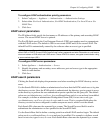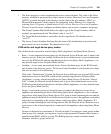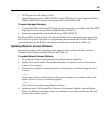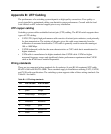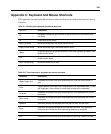
108
Cabling installation, maintenance and safety tips
Review the following important safety considerations before installing or maintaining the cables:
• Maintain the twists of the pairs all the way to the point of termination or leave no more that
one-half inch of cable untwisted. Do not remove more than one inch of jacket while
terminating the cable.
• If bending the cable is necessary, make it gradual with no bend sharper than a one-inch radius.
Sharply bending the cable can permanently damage the interior of the cable.
• Arrange the cables neatly with cable ties, using low to moderate pressure. Do not over
tighten ties.
• Where necessary, cross connect the cables using rated punch blocks, patch panels, and
components. Do not splice or bridge cables at any point.
• Keep the CAT5 cable as far away as possible from potential sources of electromagnetic
interference (EMI), such as electrical cables, transformers and light fixtures. Do not tie cables
to electrical conduits or lay cables on electrical fixtures.
• Always test every installed segment with a cable tester. Toning alone is not an
acceptable test.
• Always install jacks to prevent dust and other contaminants from settling on the contacts. The
contacts of the jack should face up on the flush mounted plates, or left, right, or down on
surface mount boxes.
• Always leave extra slack in the cables, neatly coiled in the ceiling or nearest concealed
location. Leave at least five feet at the work outlet side and 10 feet at the patch panel side.
• Choose either EIA/TIA 568A or EA/TIA 568B wiring standard before beginning. Wire all
jacks and patch panels for the KVM server module wiring scheme. Do not mix EIA/TIA 568A
and EA/TIA 568B wiring in the KVM server module installation.
• Always follow all local and national fire and building codes. Be sure to firestop all cables that
penetrate a firewall. Use plenum rated cable where it is required.




